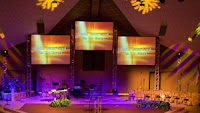 As churches prepare for the purchase of a new mixing console, this question will inevitably come up: "Should we go digital or stay analog?" Unfortunately, there is no easy answer but if you ask the right questions, you can make the right decision.
As churches prepare for the purchase of a new mixing console, this question will inevitably come up: "Should we go digital or stay analog?" Unfortunately, there is no easy answer but if you ask the right questions, you can make the right decision. Sunday, June 14, 2009
Analog vs. Digital Consoles
 As churches prepare for the purchase of a new mixing console, this question will inevitably come up: "Should we go digital or stay analog?" Unfortunately, there is no easy answer but if you ask the right questions, you can make the right decision.
As churches prepare for the purchase of a new mixing console, this question will inevitably come up: "Should we go digital or stay analog?" Unfortunately, there is no easy answer but if you ask the right questions, you can make the right decision. Wednesday, February 4, 2009
Choosing the Right Projector: Part 2
 Choosing a projector can be very confusing as you look through hundreds of pages of specifications and spend hours on the internet looking for the right machine. In this blog, we'll talk about LCD and DLP projectors and the main differences between the two technologies.
Choosing a projector can be very confusing as you look through hundreds of pages of specifications and spend hours on the internet looking for the right machine. In this blog, we'll talk about LCD and DLP projectors and the main differences between the two technologies.First, let's look at LCD technology. Liquid Crystal Display (LCD) technology has been around longer than DLP and, as a result is said to have a more mature market. LCD technology splits the light coming from the source into three separate paths: one for each of the red, green ,and blue primary colors. As the light passes through the LCD glass panels, individual pixels can be turned on or off, creating the desired color image. The lights paths are then combined and passed through the lens and onto the screen.
Digital Light Processing (DLP) technology was invented in 1991 by Texas Instruments and is based on an optical semiconductor called a digital micromirror device, or DMD. DLP projectors come in two varieties, single and three-chip models. Typically, three-chip models are only found in high-end applications with starting prices over $10,000. The DMD acts as a light switch using mirrors to direct light towards or away from a dedicated pixel space. A color wheel is used in single-chip models that synchronizes with the mirrors to provide color to the image. The light is reflected from the mirrors and passes through the lens and onto the screen. Three-chip projectors use individual chips for each of the red. green, and blue colors and use filters and steering mirrors to create the color images on the screen.
While both projectors have advantages and disadvantages, there really is no hard and fast rule for choosing which technology to use. In most cases, cost will likely be the deciding factor, but you should understand the major advantages and disadvantages of each technology.
The biggest advantage with LCD projectors is that they produce sharper, more natural-looking color images. Some have said that LCD machines are brighter, but I think that they are more correctly stated as being more efficient than DLP machines, since the light path is straight and not reflected. Colors are more closely reproduced and computer images appear to have sharper, more defined edges. Images that are displayed in rooms with larger amounts of ambient light will appear brighter on LCD projectors. The main disadvantage with LCD technology is that moving images, such as video, will appear pixelated. This has gotten better since the evolution of 3LCD, or 3-chip machines, but it is still more noticeable on LCD than on DLP projectors. LCD projectors have traditionally been physically larger than comparable DLP projectors, but this is rapidly changing as well. Another disadvantage, though it really is more of an advantage for DLP, is that blacks will usually appear gray on the screen. This is because LCD projectors have less contrast than DLP projectors.
The biggest advantage of DLP projectors is that video images appear very smooth and black images maintain more detail. At this point, I need to remind you that black detail is going to be determined by the contrast ratio, as we discussed in the last blog, however, black images do appear to be darker and more film-like on DLP projectors. The main disadvantage of DLP projectors is that color reproduction is not as good as LCD technology. Yellows and reds tend to appear washed out and require compensation, which is possible, but at the expense of brightness. Typically, DLP projectors will require more lumens to produce bright, colorful images in rooms with moderate to large amounts of ambient light.
So what do we do with all this information? Remember the three questions we used in the last blog?
- What's the budget?
- What's the purpose?
- Where's it going?
Don't be afraid to get opinions, but don't froget to do your homework. Remember, if you take the time to do your research, you will have no problem choosing the right projector.
Wednesday, January 21, 2009
Choosing the Right Projector
 Have you ever sat in a church service and not been able to read the lyrics on the screen? Or have you shown a movie on a projector only to be disappointed by the quality? There are many different elements to consider when purchasing a projector. In this blog, we’ll look at brightness and contrast ratio and how they affect the quality of the projected image.
Have you ever sat in a church service and not been able to read the lyrics on the screen? Or have you shown a movie on a projector only to be disappointed by the quality? There are many different elements to consider when purchasing a projector. In this blog, we’ll look at brightness and contrast ratio and how they affect the quality of the projected image.Let's look at contrast ratio first. We know that a ratio is a comparison between two quantities or values. Contrast ratio is the ratio of light to dark, or the number of shades of gray between white and black. If a projector claims to have a contrast ratio of 500:1, that projector uses 500 shades to define the difference between white and black. Obviously, the higher the contrast ratio number, the better the image. Typically, projectors with high contrast ratios have been geared toward home theater applications. This is because a higher contrast ration will produce a higher degree of image detail which is most noticeable in recorded or live video images. I've seen movies, such as Lord of the Rings or The Passion of the Christ, shown on brighter projectors with a low contrast ratio. While the image was nice and bright, there wasn’t enough detail in the darker sequences which made the projector seem to struggle to project the image.
Now, let's talk about brightness. The American National Standards Institute or ANSI is an organization that oversees product standards in the United States. This organization developed a standard by which the brightness of a projector should be measured and marketed, which involves averaging several measurements taken at various positions. This has been the standard for choosing projectors for many years and is still the means by which most projectors are purchased today. A lumen is a unit of luminous flux, which is the measure of perceived power of light energy. As is the case of contrast ratio, the higher the ANSI lumen number, the better or brighter the image. As moving images become more popular in backgrounds for worship, a bright projector is critical for displaying words (such as song lyrics or scriptures) that the audience can read.
So, which specification is more important, brightness or contrast ratio? Well, that depends on your application and budget. There's no question that we're seeing projectors today that are brighter and less expensive than we could have imagined five years ago. And now, some of those projectors have contrast ratios up to 10,000:1.
If you are in the market for a new projector, ask yourself (and your team) three questions:
- What's the budget?
- What's the purpose?
- Where's it going?
This is the first in a series of blogs that will cover the different aspects of choosing the projector that is right for you.
Sunday, January 18, 2009
No time for a sound check…
This was at a time when solo tracks came only on cassette and the tape contained the demo track on one side and the solo track in two or three keys on the other side. I had worked with these tracks many times and felt quite certain that a quick spot cue would be sufficient. BIG mistake!
The service progressed and the time came for the big solo. The music started at the perfect time and the audience waited with great anticipation to hear this lady lift up an amazing praise offering to our Lord. However, what they heard was a duet that included a very surprised soloist and the superstar that recorded the demo track.
I immediately stopped the tape and the Pastor took the cue, went to the pulpit and spoke for a minute to give me time to re-group. Without looking to see how the tape was inserted, I pulled the tape out, made sure I was using the correct side, cued the tape, and restarted the song.
Again, the congregation waited, and again they received a duet instead of a solo. By this time, the Worship Leader was on his way to the sound booth (never a good thing) and I was completely frustrated. Again, the Pastor got up and spoke to give us time to sort out this painful situation.
As it turned, out the tape had been mislabeled and the solo tracks were on the side of the tape labeled demo. A quick sound check would have prevented this disaster and quite a bit of humiliation. As the sound engineer, I should have insisted on at least a mic check with a minimal track check. If I had done this, I would have realized that the tape had been mislabeled and saved myself and the church much embarrassment.
Sound checks are not just for the performers - they are for everyone involved. Here are some things that should be done during a sound check from the engineer’s perspective:
- Make note of the mic(s) being used
- Make note of the levels - monitor and house
- If an accompaniment track is being used, make note of the track number and/or track key to be used
- If the track is on a cassette tape, cue the tape
- Make sure the performer is comfortable with what they are hearing and confident that you, the sound engineer will make them sound good
As a sound engineer, we need to work closely with the Worship Leader to eliminate the possibilities for errors. Not only does this create embarrasing situations, it is very distracting to the congregation. Remember, this might be the only opportunity we get to relay the Gospel of Jesus Christ to someone whe needs it, so let’s make sure we don’t blow it with a preventable mistake!




